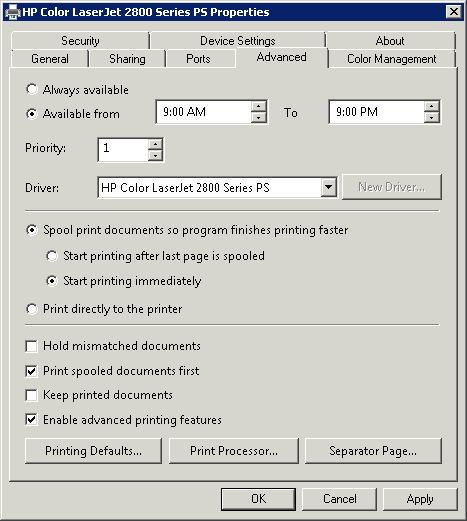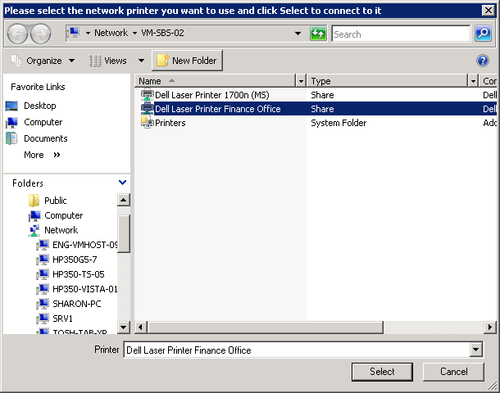6. Setting Security Options
Security options come into play when you have a range of
printers that are separate but not at all equal. For
example, you might not want everyone to print to the
five-dollar-per-page, dye-sublimation printer purchased for the art
staff. At a more down-to-earth level, security settings can preserve
printer properties or printing priorities from unauthorized changes.
To set permissions on a printer, right-click the printer,
choose Printer Properties, and then use the Security tab to assign
permissions to groups of users. Click Advanced to exert finer control
over permissions or to enable auditing. You can view the results of
the audit settings in the security log.
A printer has three levels of permissions: Print, Manage
Documents, and Manage Printers. These are defined as follows:
Print Users or groups with
Print permission can connect to the printer; print
documents; and pause, restart, or delete their own documents from
the print queue. Windows, by default, grants members of the
Everyone group the Print permission.
Manage Documents Users or
groups with Manage Documents permission have the Print
permission along with the ability to change the settings for all
documents in the print queue and to pause, restart, and delete any
user’s documents from the print queue. Windows grants the
Creator/Owner group the Manage Documents permission level by
default.
Manage Printers Users or
groups with Manage Printers permission have the Manage Documents
and Print permissions along with the ability to modify printer
properties, delete printers, change printer permissions, and take
ownership of printers.
6.1. Determining Printer Availability
To set up a printer to be available only during certain
times—perhaps to discourage after-hours printing—complete the
following steps:
In the SBS Console, right-click the printer you want to
modify and select Printer Properties from the shortcut
menu.
Click the Advanced tab, and then click Available
From.
Select the earliest and latest times the printer is to be
available to users, and then click OK.
6.2. Group Priorities and Printer Availability
Changing printer availability as just described changes the
printer use times for everyone and makes no further restrictions.
With a few additional steps, you can set up a printer so that print
jobs submitted by some users print before jobs submitted by other
users; for example, you can give priority to managers or groups with
tight deadlines. You can also reserve a printer for exclusive use by
certain groups during certain times; for example, you can reserve a
printer outside of normal business hours so that the groups you
specify can print large, high-priority print jobs.
To control availability or group priority, create two or more
logical printers for a single physical printer, give each
logical printer a different priority and/or make it available at
different times, and give different sets of users or groups
permission to print to each logical printer.
6.2.1. Creating a Logical Printer
To create a logical printer, follow these steps:
Select Control Panel from the Start menu. Under
Hardware, click View Devices And Printers.
From the File menu, select Add A Printer.
Note:
If the menu bar isn’t visible in the Printers window,
press Alt to display it.
In the Add Printer dialog box, select Add A Local Or
Network Printer As An Administrator.
In the next Add Printer dialog box, select Add A Local
Printer.
In the Choose A Printer Port dialog box, click Use An
Existing Port, select the port that the physical printer is
on, and then click Next.
In the Install The Printer Driver dialog box, choose the
manufacturer name from the list on the left and the printer
model from the list on the right. Click Next.
Choose the version of the driver you want to use and
click Next.
Give the printer a name that describes its function or
who uses it. Click Next.
In the Printer Sharing dialog box, provide the location
and additional comments if wanted. Click Next.
6.2.2. Configuring Usage of the Logical Printer
When the logical printer exists, you next configure how it
is used and by whom. Open Control Panel and follow these
steps:
Under Hardware, select View Printers And Devices.
Right-click the logical printer and select Printer
Properties.
Click the Security tab, and assign permissions to the
users or groups that will have special access to this
printer.
Click the Advanced tab (shown in Figure 8). If the logical
printer is to be available only at certain times, select
Available From and set the times.
To change the priority of the users and groups that use
this logical printer, type a number in the Priority list box.
The priority range goes from 1, which is the lowest priority,
to 99, which is the highest priority.

Click OK, and repeat the process for all other
logical printers you created for the
printer.
6.2.3. Viewing the Logical Printer in the SBS Console
As when installing a new printer, the logical printer might
not automatically appear in the list of network devices in the
Windows SBS Console. If this is the case when you view the
Printers list, first click Refresh This View in the
Tasks pane. If the printer still doesn’t appear, follow these
steps:
Click List A Shared Printer In This Console, and browse to the printer as shown in
Figure 9.

Click Select and then click OK.
In the Windows SBS Console, click Refresh This View in
the Tasks list. The printer appears in the list of printers.